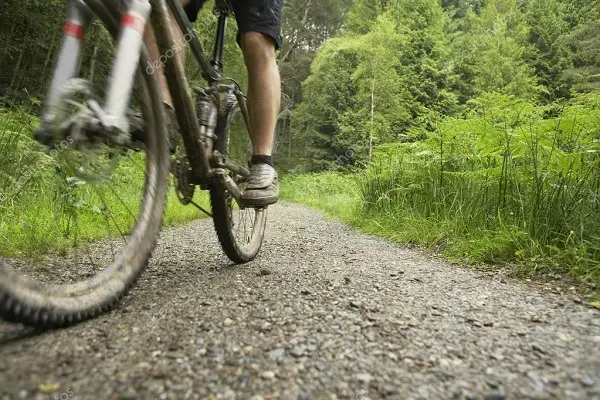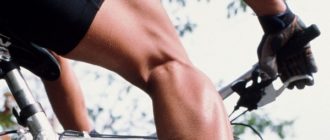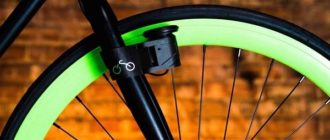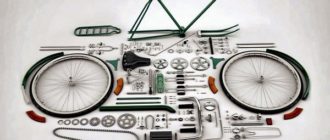The key to safe cycling is knowing how to brake at the right moment. It would seem that there is nothing difficult about it. Then why do some cyclists fly over the handlebars? Or why does the bike start to skid while stopping? As life practice shows, improper use of the front and rear brakes, depending on the specific situation, leads to exactly these consequences. That is why it is so important to understand when and which brake should be used. In addition, it is very important that they work at the same time. Please note that the leading brake is the front brake. Therefore, dear cyclists, you have to overcome the fear of flying over the handlebars and learn how to brake properly on a bicycle.
How does the braking process work?
The vast majority of modern bicycles are equipped with one of the following types of braking system:
- disc brakes;
- hydraulic;
- V-brakes.
Accordingly, deceleration of speed and full stopping of the bicycle will take into account the specifics of the particular type and the elementary laws of physics. When stopping a bicycle, it is necessary to balance the force of gravity against inertia. Modern sport or mountain models are equipped with front and rear brakes. Simply locking the wheels means accelerating tire wear and completely negating the braking system. All this means is that every cyclist who regularly goes out for a ride needs to learn how to use both braking systems.
On dry roads.
Braking efficiency can be increased by using both brakes on the edge of wheel lock. With it, braking is done by rubbing the tires against the asphalt, and the bike’s specially designed system does nothing for it.
We repeat what we have learned: to reduce the speed of the bike in standard situations, you need to use the front brake. Most cyclists are afraid to use it because they think they can go on a short but thrilling flight over the handlebars. To eliminate this possibility, you should shift your body weight to the pedals and hold that position until the bicycle comes to a complete stop.
On Wet Roads
Mountain biking in the rain is not the best thing to do. But there are times when you have to ride in puddles through no fault of your own. In this situation it will not be superfluous to know how to brake on a speed bicycle. On wet asphalt the grip of the tires with the surface is much less. The most dangerous moment is the beginning of rain, when the water has not yet had time to wash away all the road dust, resulting in a very slippery substance. This should be taken into account when choosing speeds and maneuvering. Keep in mind that a wet braking system becomes less effective.
To reduce speed and come to a complete stop, you need to apply the disc brakes. Braking should be planned in advance if possible: to do this, you should dry the pads with a few short strokes (this will help them regain their proper properties).
Important: In wet weather the tires’ grip is extremely unreliable. Using the front brake, you can not calculate the force, as a result of which the wheel will be blocked. Therefore it is better to start decelerating and stopping on a wet surface with the rear brake. Even if the wheel locks and the bike goes in a skid, it is possible to cope with the skid. To brake more effectively, you should shift your body’s center of gravity from the front to the rear axle of the bike: this will put more weight on the wheel, increasing its grip.
Caution. Road markings and manholes become particularly slippery in the rain. If possible, avoid braking on these areas of the road.
On an uneven surface
The main thing here is to understand, when it is necessary to start braking. Apply force on the downhill should be at the right moment. Remember that the front wheel is under more strain than the rear. Using the front brake allows you to take control of the situation and makes it easier to control the movement of the bike. It also helps you avoid skidding. Keep in mind that if you apply the front brake handle too much, you run the risk of flying over the handlebars.
To prevent this from happening, move your center of gravity to the rear wheel, thereby increasing its braking force. This way you can distribute the load evenly on both axles of the bike, ensuring that the front and rear brakes work effectively.
Caution! If you hold the front brake lever when the rear wheel is off-loaded or has just come off the ground, the wheel will lock. Landing on it is fraught with the risk of a fall.
While turning.
It is extremely undesirable to use the brakes while turning. It is necessary to reduce speed before the start of the maneuver. But if it so happens that the speed in the turn is too high, you need to clamp both levers. When braking in a turn, you should take into account that both wheels are in an unloaded state. The lower the weight of the bike and rider, the less effort you have to apply to reduce speed in a turn.
If one of your wheels is damaged
A punctured wheel is not such a rare occurrence. Continuing to ride in this case is extremely unsafe. You cannot use the brake of the damaged wheel – you must stop using the braking system of the whole. A tire that has come off the rim may block the wheel. The result is predictable: you could fall.
On a slippery surface
Here there is no time for maneuvers and sudden movements. The main task of a cyclist – to keep the balance. Therefore, it is desirable to bypass such a stretch of road or to overcome it at a minimum speed. If it is still necessary to brake, it is better to use the rear brake. Using the front brake is fraught with skidding. It is necessary to stop by smooth and short pressing the handle.
If suddenly the rear wheel starts to skid, you need to immediately release the braking force and allow it to resume rotation.
Drop Braking
Surprised? Yes, this method exists, too. You have to know how to fall correctly, too. It is clear that this method of braking should be used only in emergency situations and, if possible, try to get out of them with minimal consequences. If you understand that any other way to stop the bike can not, plan a side fall. Remember that flying over the handlebars is fraught with injuries to the neck, head and spine. When jumping backwards, when the bike as if jumping out from under the rider, there is a risk of damaging the coccyx, back and spine. Moreover, a bad fall can be fatal if the back of the head hits the pavement hard. Therefore, falling on your side will be the best option.
To do this, you need to lock the rear wheel and roll the bike to the side on which you plan to fall. You need to act and make decisions quickly. Learning how to properly brake on a bike is better in the winter, when the pavement is the perfect springboard to hone your skills.
Using the front and rear brakes at the same time
This is probably the best and safest braking technique. In fact, pressing the handles is not exactly simultaneous: the rear brakes need to be started a few moments before the front brakes. First, you have to gently squeeze the rear brake handle and after a fraction of a second, you start the front brakes (they need to be squeezed a little harder). The secret lies in the smoothness of your movements.
No matter how unexpected the situation was, to panic and make sudden maneuvers is definitely not worth it. Mind of a cyclist should always remain cool. After all, one wrong move can cripple not only you but also those around you. So it makes sense to train and hone your braking skills. Learn to “listen” to a back wheel and catch its behavior at operation of braking system.
Where best to put the front brakes on the handlebars: nuances
Cyclists around the world still can not decide where it is better to put the front brakes: left or right. The confusion is further exacerbated by a common misconception that the leading are the rear brakes. It would seem that there is not much difference. But there are certain nuances in the installation of the handle:
- On motorcycles, the handle is located on the right. Logically, the front brake handle on a bicycle should also be located there.
- In countries with right-hand traffic, the brakes are placed so that the left hand controls the front brake.
- In left-handed countries, the opposite is true.
In our country, you can find bicycles with both lever arrangements. As life practice shows, it is still the front brake that leads, so it is more logical to put it on the right side. If you are left-handed, you can put it on the corresponding side of the handlebar.
Recommendations
No matter which brake system is fitted to your bike, there are some generally accepted principles that you should never ignore:
- Always make sure the brake system is in good working order.
- Avoid riding on wet and uneven surfaces.
- Try to conquer the fear of using the front brake.
- When braking with the front wheel, do not ignore the behavior of the rear: as a rule, the rear brake accounts for about 20% of the load.
- Effective braking is helped by hand-hold the wheel firmly and confidently.
- If a fall cannot be avoided – try to fall on your side.
Only someone who gets on a bicycle once a month for a leisurely walk in the evening may not sharpen their braking skills. Everyone else who regularly rides a bike needs to learn how to properly use the rear and front brakes.
Conclusion
To summarize, it is not that difficult to brake properly on a bicycle with disc brakes if you practice well and learn the sequence of actions in any situation. Remember, your life and health depend on your ability to stop your bike in the right moment.









